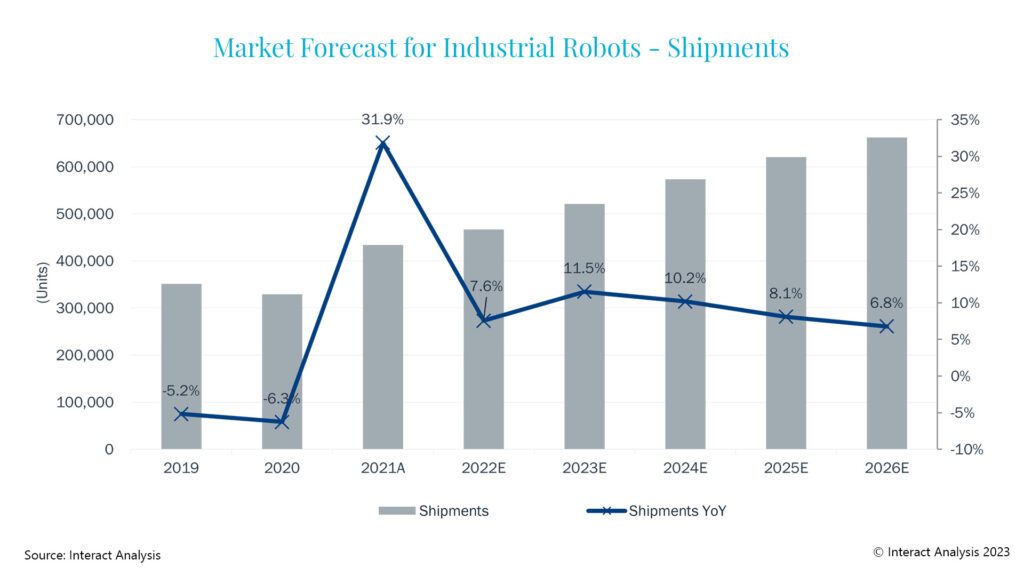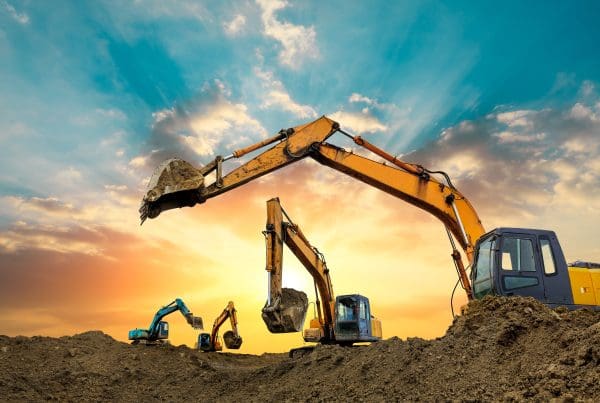工业自动化
2023-01-25
工业和协作机器人市场的几点发现

MAYA XIAO
Maya在电动汽车、自动化系统和机器人领域拥有跨学科的技术背景,现担任Interact Analysis的研究经理,负责锂离子电池、叉车、工业和协作机器人市场等研究。
New market insight by Interact Analysis outlines some key takeaways from 2022 for the industrial and collaborative robot market. Also in this insight, key trends anticipated in these markets throughout 2023 are discussed.
Industrial Robots: 8% growth… but far behind forecast
Europe has been heavily impacted by the war in Ukraine and the subsequent energy crisis. Moving to the West, North America is troubled by inflation and supply chain problems. And in the East, the Asia Pacific region, especially China, has been adversely affected by the COVID-19 control measures in 2022, with the manufacturing industry in particular encountering difficulties in production and delivery. In 2022, the global industrial robot market is expected to have grown by 8%, lower than our forecast made at the beginning of the year.

In 2022, the global industrial robot market is expected to have grown by almost 8%.
Taking a look at the market by type of robot, the growth rate of the market for collaborative and articulated robots with medium and high payload was very high last year. In 2022, the annual growth rate of collaborative robot shipments was ~17%; the annual growth rate of shipments of medium-high payload articulated robots was around 15%. This was mainly due to the continuous automation investment in new energy vehicles and parts, batteries, and logistics. However, over the year, shipments of SCARA robots experienced a decline overall due to the weakness of the electronics industry. It is worth noting that the proportion of SCARA robots with large loads (>20kg) being shipped has increased significantly, as they are mainly used in the battery manufacturing and material handling sectors.
The price of robots continues to rise worldwide because of supply and demand inequalities. Many major robot manufacturers have raised the factory price in 2022, causing the average selling price (ASP) of industrial robots to rise for the first time in many years. In 2022 alone, ASP in the sector rose by around 7% and this trend is predicted to improve in the coming years.
Looking forward to 2023, supply chain constraints within the manufacturing industry are continuing, major manufacturers still have delivery problems, and the prices of raw materials and parts have not stabilized. This has brought a lot of uncertainty to the market. However, in combination with the considerable order volume in 2022 and rising demand from the manufacturing industry, Interact Analysis predicts robot shipments will maintain a 7% to 9% rate of annual growth in 2023. The Asia-Pacific market has recovered moderately, but the European market is still finding growth more constrained.
In the long run, demand for automation in the manufacturing industry is still growing, and the industrial robot market is expected to maintain an average annual growth rate of 5% to 7% in the next five years.
Collaborative Robots: the fastest growing market
In 2022, collaborative robots continued to be the fastest growing market, with shipments increasing by 17% and sales rising by 20%. Prices are slightly higher than they were in 2021 for collaborative robots. The cold winter has had a negative impact on the sales of collaborative robots in the electronics and semiconductor industry, particularly in the Asia-Pacific region. However, regionally, growth of collaborative robots in Southeast Asia is booming at present, with many robot manufacturers and system integrators following customers to Southeast Asian countries where there are new factories presenting opportunities. In 2023, global growth of collaborative robot shipments is anticipated to be around 20%, in line with the forecast Interact Analysis released in October. However, there have been some changes in regional markets:
- The Asia-Pacific region, especially China, has benefited from the complete shift in COVID policy (from zero-Covid to fully open). As a result, market growth for robots in 2023 will be higher than previously predicted.
- On the other hand, the impact of inflation and the energy crisis is still severe, with the main impact on demand in markets in Europe and North America. Interact Analysis predicts that the growth rate of these two markets will decline and may fall back to single-digit growth.
In general, demand for collaborative robots in non-industrial applications has not boomed as previously predicted. Vendors’ investment intentions are currently not clear, and the global economic climate has placed huge constraints on supply chain management processes, which is placing subsequent pressure on the robotics market.
On the other hand, compared with large companies, small and medium-sized enterprises, which account for a high proportion of downstream customers of collaborative robots, are less resistant to risk and uncertainty. Survival is their main priority, so they need to secure cash flow in order to manage the current challenging climate, making them more cautious about capital investment. This is one of the reasons why we have reduced the growth forecast of collaborative robots in the manufacturing industry in the short term. But in the long run, the demand for automation is still significant and stable.
Global Recovery:
In terms of recovery, we predict that Asia-Pacific will begin to recover in the first half of 2023 and Europe from the second half of the year and into early 2024. Recovery in the United States will take a while longer due to the economic constraints the market is currently facing. According to Interact Analysis’ latest manufacturing output tracker, the manufacturing downturn in the United States will be postponed from 2023 to 2024.
Final Thoughts:
It is clear that the current economic climate is placing constraints on all markets. While the global industrial robot market enjoyed positive growth in 2022, it is far from the strong forecast made by Interact Analysis at the beginning of the year. The situation was a little rosier in the collaborative robot market and continues to look that way in 2023, with shipment growth of 20% forecast. Nevertheless, supply chain constraints will continue to put pressure on all markets. Full recovery from the aftereffects of the pandemic, economic pressures and supply chain challenges is not expected until 2024, with the US taking the longest to fully bounce back.
For more information on the industrial robot and collaborative robot markets, please contact Maya Xiao, Senior Analyst at Interact Analysis.
其他商用车领域洞察

非道路领域是否已迎来高性能计算平台时代?

2024年,巴西挖掘机进口五倍于出口
